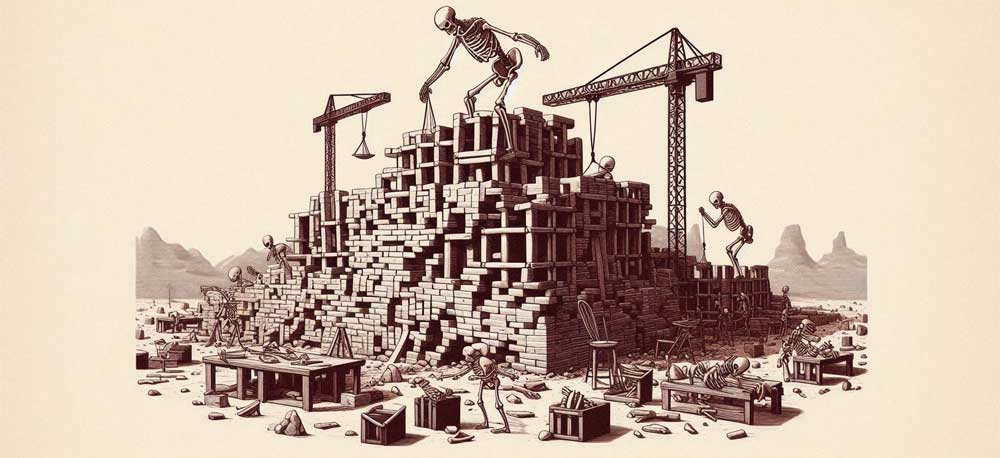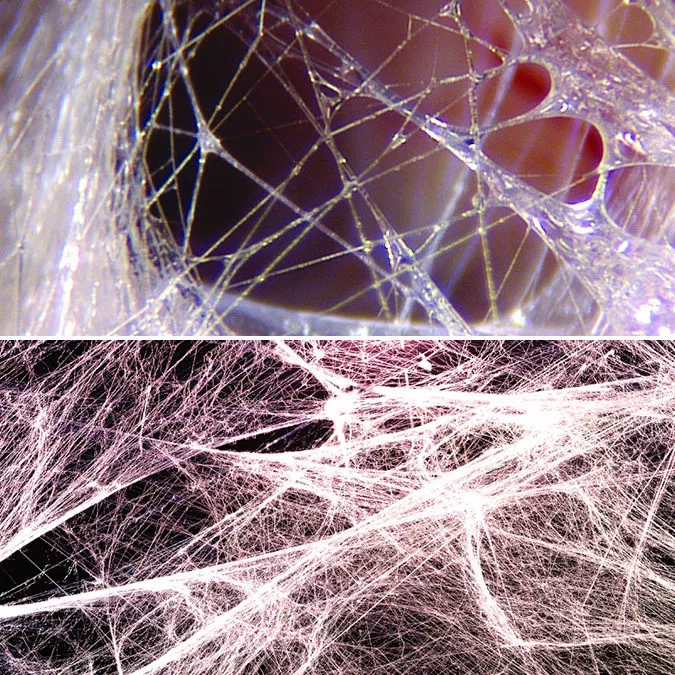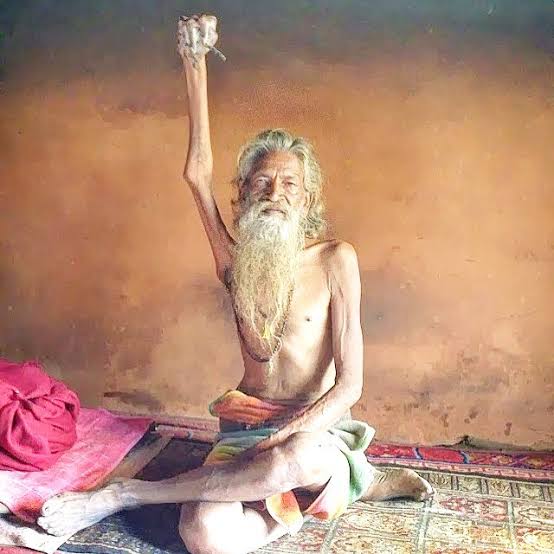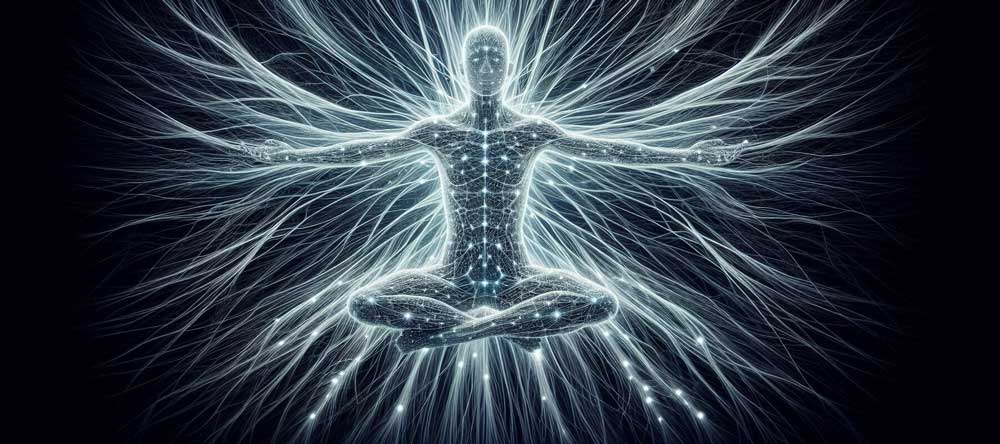Buckminster Fuller coined the term “tensegrity” in the 1960s to describe a new kind of architectural structure that relied on a balance of tension and compression to maintain its stability. The word is literally a combination of the words tension and integrity. In traditional architecture, the load-bearing elements of a structure are typically arranged in a compressive arrangement, where solid elements are piled on top of each other to distribute weight and resist external forces, think of a wall of bricks. In contrast, tensegrity structures use a network of tensioned cables or rods to suspend the compressive elements, creating a dynamic equilibrium that allows the structure to maintain its shape without collapsing. This approach to architecture has been applied to a wide range of structures, including bridges, towers, and even sculptures.

In tensegrity structures, the tension elements (such as cables or strings) are under tension, pulling the structure apart, while the compression elements (such as struts or bars) are under compression, pushing the structure together. The balance between tension and compression is what gives tensegrity structures their stability and allows them to maintain their shape.
But what has architecture have to do with wellness and the human body?
We have viewed our skeleton as one bone stacked on top of the other, held together by ligaments and moved around like a crane by individual muscles. Our propped-up classroom skeletons reinforcing this notion.
But if we could magically eliminate the soft tissues, our bones would not stay locked aloft but crash ignominiously in a heap. This simple thought experiment should be enough to convince us that we are not ‘continuous compression’ structures like a wall of bricks or even a crane, but rather ‘tension-dependent’ structures.
Graeme Scarr is a manual therapist and educator who has developed his own approach to tensegrity-based manual therapy. In his approach, Scarr emphasizes the importance of considering the body as a whole, interconnected system in which tension and compression forces are balanced through the principle of tensegrity.
Scarr has applied the concept of tensegrity to various parts of the body, including the cranium and rib cage. According to Scarr, the cranium is a tensegrity structure consisting of bones, membranes, and cerebrospinal fluid. He argues that the bones of the skull are not tightly fused together, but are instead held in place by a network of fascia and membranes. This allows for a subtle movement of the bones, which is essential for the normal functioning of the brain and nervous system.
Similarly, Scarr views the rib cage as a tensegrity structure that helps to balance the forces of breathing and movement throughout the body. He suggests that the rib cage is not simply a series of rigid bones but is instead a dynamic system that responds to changes in posture and movement. By working with the rib cage and other parts of the body as tensegrity structures, Scarr believes that manual therapists can help to restore balance and function to the body as a whole.

Fascia – The web that we weave
Fascia is a connective tissue that surrounds and supports muscles, bones, and organs in the body. It is made up of a network of fibrous tissue, which is composed of collagen fibers and elastin fibers that form a web-like structure. The fibers of fascia are often described as threads or strands that weave together to create a strong and flexible network that provides support and stability to the body.
The fascial system is an interconnected network of tissue that spans the entire body, from the top of the head to the tips of the toes. It provides a framework for the body and helps to distribute forces and stresses evenly throughout the body. The fascial system also plays an important role in movement and flexibility, allowing muscles to glide smoothly over one another and facilitating smooth and efficient movement.

The fibres of fascia are incredibly strong and flexible, able to withstand significant tension and deformation without breaking or tearing. They are also highly adaptive, able to change their shape and structure in response to changes in the body or the environment. For example, fascia can become thicker and more dense in response to chronic stress or injury, or it can become more pliable and elastic with regular stretching and exercise.
An extreme example of the dangers of a sedentary lifestyle is exemplified by Sadhu Amar Bharati a sadhu who has been living in the Himalayas for more than four decades. He is known for his extreme devotion to Lord Shiva and his unique practice of keeping his right arm raised continuously for over 40 years. The non-movement of fascia in Sadhu Amar Bharati’s arm has caused his skin to fuse with the underlying tissue, making it almost impossible for him to lower his arm without causing significant pain and permanent damage. In addition to this, his arm has become severely atrophied and has lost most of its muscle mass, which has made it difficult for him to carry out everyday activities.


The adage “you are what you eat” can equally be extended to “you are how you move.” If you spend a large proportion of your life in a coach potato position your fascia will weave to support and bind you in this position. Just as there exists a compelling case for adhering to a paleo diet based on what our bodies have evolved to consume, we should also strive to move in ways that optimize our inherent potential, as shaped by the history of our species. We were meant to move and enjoy expressing ourselves with our bodies, if you don’t use it, you lose it.
Tensegrity of the spirit
Like the fascia is a web of fibres that weave together to connect and hold the body together. Many spiritual traditions describe a network of energetic or spiritual fibres of light that interconnect everything in the universe. For example in Hinduism and Yoga, the concept of nadis describes a network of subtle energy channels that carry prana (life force energy) throughout the body and connect it to all . Traditional Chinese Medicine describes a system of meridians or channels that carry qi (vital energy) throughout the body, and acupuncture is based on manipulating the flow of qi through these channels. In Kabbalah, the Tree of Life is a symbolic representation of the divine energy that flows through the universe, and the sefirot (emanations) are described as channels through which this energy flows. In Sufism, the concept of the subtle body includes a network of energetic channels and centres, including the chakras, that are related to spiritual development and awakening. In some indigenous traditions, such as those of the Amazonian shamanic practices, a network of energetic or spiritual fibres is believed to connect humans, nature, and the spiritual realm.

Carlos Castaneda shared a series of movements that he called magical passes that he claimed were passed to him from a long lineage of Toltec sorcerers, who had developed them over thousands of years. Intriguingly he named the system tensegrity, the name coined by Buckminster fuller discussed earlier in this article. Discussing how we should change our view the It is a form of movement and meditation that involves a series of postures and movements aimed at developing awareness and energy. The practice can be related to movements from various traditions, including yoga, Qigong, martial arts, and dance.
According to Castaneda, regular practice of these techniques could lead to increased awareness and the ability to perceive the world in a different way. He claimed that practitioners could develop a heightened sense of perception, greater physical and emotional control, and increased energy and vitality. Castaneda also suggested that the practice of these techniques could help individuals achieve a state of inner silence, which he believed was necessary for personal transformation and spiritual growth.
With greater practice of these movements as well as an adoption of the sorcerers way of life he shared stories of the supernatural possibilities with these practices and awareness. That incredibly practitioners could learn to fly through the use of their own personal power. Become invisible to others by shifting their energy and could learn to shift their physical form into that of an animal or other object. Castaneda also suggested that practitioners could learn to travel through time and visit different eras and dimensions.
His descriptions of the use of the luminous fibres by sorcerers such as Don Juan and Genaro beautifully illustrate the technique and why the connection with concept of tensegrity is so appropriate. Her are some quotes from his book that wonderfully elucidate the possibilities.
“Don Genaro was a master of the art of weaving his luminous fibers, and he could use them to create all kinds of effects. He could make himself invisible, he could create illusions, and he could even project his awareness into other realms of reality. But his most impressive talent was his ability to move with incredible speed and agility. He could compress himself into a tiny ball and then expand outward with explosive force, and he could cover enormous distances in the blink of an eye. His movements were so fluid and dynamic that they seemed to defy the laws of physics.” (from “The Art of Dreaming”)
“Don Genaro was talking to me in a low voice about the luminous fibers, explaining that they were like fibers of light that crisscrossed the universe. He said that the fibers were the key to everything, that they held the universe together. Then he suddenly stood up, and I saw that he had grown to an enormous size. He was like a giant, towering over me. Then he shrank back down to his normal size and sat down again.” (The Power of Silence)
